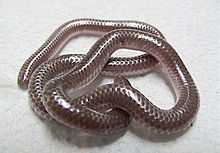Leptotyphlops dulcis
| Leptotyphlops dulcis | |
|---|---|
 | |
| Scientific classification | |
| Kingdom: | Animalia |
| Phylum: | Chordata |
| Subphylum: | Vertebrata |
| Class: | Reptilia |
| Order: | Squamata |
| Suborder: | Serpentes |
| Family: | Leptotyphlopidae |
| Genus: | Leptotyphlops |
| Species: | L. dulcis |
| Binomial name | |
| Leptotyphlops dulcis (Baird & Girard, 1853) | |
| Synonyms | |
| |
Leptotyphlops dulcis is a blind snake species found in the southwestern United States and northern Mexico. Three subspecies are currently recognized, including the nominate subspecies described here.[2]
Description
Leptotyphlops dulcis appears much like a shiny earthworm. They are pinkish-brown (puce) in color with a deep sheen to their scales. They appear not to be segmented. Their eyes are no more than two dark dots under the head's scales. Their mouths are small and set in an underbite. Adults can grow to approximately 20 cm (7.9 in) in length.
On the top of the head, between the ocular scales, L. dulcis has three scales (L. humilis has one scale).[3]
Behavior
Texas Blind Snakes spend the vast majority of their time buried in loose soil, only emerging to feed or when it rains and their habitat floods with water. Blind snakes are often found after spring rains and mistaken for earthworms. If handled they usually squirm around and try to poke the tip of their tail into the handler. This is a completely harmless maneuver and likely serves as a distractive measure. Their mouths are far too small to effectively bite a human being.
Feeding
Their diet consists primarily of termite and ant larvae.
Common names
Texas slender blind snake, Texas threadsnake,[2] Texas blind snake, plains blind snake.
Subspecies
| Subspecies[2] | Authority[2] | Common name | Geographic range |
|---|---|---|---|
| L. d. dissectus | (Cope, 1896) | New Mexico blind snake | |
| L. d. dulcis | (Baird & Girard, 1853) | Plains blind snake | |
| L. d. myopicus | (Garman, 1884) | ||
Geographic range
Found in the southwestern United States and northern Mexico. In the USA it occurs in southwestern Kansas, western Oklahoma including the panhandle, central & south Texas west through southern New Mexico to southeastern Arizona. In northern Mexico it has been reported in Chihuahua, Coahuila, Tamaulipas, Nuevo León, San Luis Potosí, Veracruz, Querétaro, Hidalgo and Puebla. The type locality given is "Between San Pedro and Camanche Springs Tex." (Comanche Springs, Texas).[1]
Conservation
Gauging wild blind snake populations is virtually impossible due to their secretive nature. However, like many other native Texas species, they are known to be detrimentally affected by the red imported fire ant.
See also
- List of leptotyphlopid species and subspecies.
- Leptotyphlopidae by common name.
- Leptotyphlopidae by taxonomic synonyms.
References
- ↑ 1.0 1.1 McDiarmid RW, Campbell JA, Touré T. 1999. Snake Species of the World: A Taxonomic and Geographic Reference, vol. 1. Herpetologists' League. 511 pp. ISBN 1-893777-00-6 (series). ISBN 1-893777-01-4 (volume).
- ↑ 2.0 2.1 2.2 2.3 2.4 "Leptotyphlops dulcis". Integrated Taxonomic Information System. Retrieved 30 August 2007.
- ↑ Smith, H.M. & E.D. Brodie, Jr. 1982. Reptiles of North America: A Guide to Field Identification. Golden Press. New York. pp. 136-137.
External links
 Media related to Leptotyphlops dulcis at Wikimedia Commons
Media related to Leptotyphlops dulcis at Wikimedia Commons- Leptotyphlops dulcis at the Reptarium.cz Reptile Database. Accessed 30 August 2007.
- Leptotyphlops dulcis, Texas Blind Snake at DigiMorph.
- Leptotyphlops dulcis at Life is Short but Snakes are Long